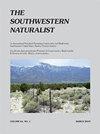王泡棉亚属花粉粒形态。Kaibabensis和两个同系物
IF 0.2
4区 环境科学与生态学
Q4 Agricultural and Biological Sciences
引用次数: 0
摘要
摘要本研究主要研究了王绒泡属(Physaria kingii)的花粉形态。kaibabensis和两个同系物,Physaria arizonica和p.k iii亚种。在亚利桑那州凯巴布高原发现的latifolia,以进一步区分这些物种。我们采集了2个样点/种的植物资料,每样点10株,每株10粒花粉。利用扫描电镜对花粉粒(极轴[P]、赤道直径[E]、P/E比值、形状、外壁结构和孔径数)进行了描述。所有被成像的物种都有网状表面的花粉粒,并且是五焦酸的。物种间赤道径和市盈率差异显著,但极轴差异不显著。这项研究为物种描述提供了额外的信息。本文章由计算机程序翻译,如有差异,请以英文原文为准。
POLLEN GRAIN MORPHOLOGY OF PHYSARIA KINGII SUBSP. KAIBABENSIS AND TWO CONGENERS
Abstract In this study we focus on the pollen morphology of Physaria kingii subsp. kaibabensis and two congeners, Physaria arizonica and P. kingii subsp. latifolia, found on the Kaibab Plateau, Arizona, to differentiate further among these species. We collected plant material from 2 sites/species, with 10 plants/site used to image 10 pollen grains/plant. We described pollen grains (i.e., polar axis [P], equatorial diameter [E], P/E ratio, shape, exine structure, and aperture number) using scanning electron microscopy. All species imaged had pollen grains with reticulate surfaces and were pentacolpate. We found significant differences among species for equatorial diameter and P/E ratio, but not for polar axis. This study provides additional information that can be incorporated in species descriptions.
求助全文
通过发布文献求助,成功后即可免费获取论文全文。
去求助
来源期刊

Southwestern Naturalist
环境科学-生态学
CiteScore
0.50
自引率
50.00%
发文量
47
审稿时长
18-36 weeks
期刊介绍:
The Southwestern Naturalist (a publication of the Southwestern Association of Naturalists since 1953) is an international journal (published quarterly) that reports original and significant research in any field of natural history. This journal promotes the study of plants and animals (living and fossil) in the multinational region that includes the southwestern United States, Mexico, and Central America. Appropriate submission of manuscripts may come from studies conducted in the countries of focus or in regions outside this area that report significant findings relating to biota occurring in the southwestern United States, Mexico, and Central America. Publication is in English, and manuscripts may be feature articles or notes. Feature articles communicate results of completed scientific investigations, while notes are reserved for short communications (e.g., behavioral observations, range extensions, and other important findings that do not in themselves constitute a comprehensive study). All manuscripts (feature articles and notes) require an abstract in both English and Spanish.
 求助内容:
求助内容: 应助结果提醒方式:
应助结果提醒方式:


